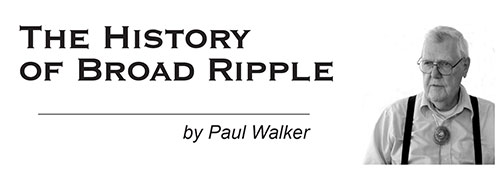
|
Broad Ripple Random Ripplings

The news from Broad Ripple
Brought to you by The Broad Ripple Gazette
(Delivering the news since 2004, every two weeks)

|
| Brought to you by: |

|

|

|

|

|

|
Converted from paper version of the Broad Ripple Gazette (v03n21)
The History of Broad Ripple - The King of Classic Cars in Broad Ripple: part two - by Paul Walker
posted: Oct. 20, 2006

The King of Classic Cars in Broad Ripple: part two
Although the car pictured (see last issue) rivaled the Duesenberg, it had only 165 horse-power vs. the Duesie's 320 horse-power when super charged. The Stutz could go 100 or so; the Duesie 90 in second gear and have been clocked at 120 MPH. Initial cost for the Stutz would buy 17 Fords or Chevrolets; for the Duesie 50 Fords or Chevrolets.
Even so, someone in the bank obviously owned the car and it wasn't a clerk or a teller. Mr. William Dawson was the bank president, but a bank president's salary probably wouldn't have covered the cost. However, all of the Dawsons in Broad Ripple were landed and had money. I remember him both in the bank and in the Methodist church a half block south. He was a sturdy-looking man with a powerful bass voice. I heard he could rattle the windows with it. Singing, he could be seen joyfully waving his hands in the air. (The Methodists were all noisy back then!) The noisiest one was a Mrs. Tridie. She had a mezzo-soprano voice that she used with gusto. It wasn't just loud; it was awe-inspiring with a remarkable ululation. She outsang the choir and everyone except Mr. Dawson.
It should be noted that Stutz also built fire engines. Indianapolis was equipped with them almost exclusively, as was Broad Ripple. I worked one summer in construction for a builder who had been, as a young man, chauffeur for the head fire chief. He had driven a Stutz sedan with a red light and siren and that was equipped with the special Stutz safety glass. We have safety glass today but the Stutz glass had wires imbedded in it to prevent shattering. The car was called, therefore, the "Safety Stutz".
A final note on this car, from 1930 on, 12 and 16 cylinder cars were produced until the mid to late 30's (Lincoln Continentals with a small V-12 engine were built through 1948). Stutz did not have the money to up the ante, so they labeled their big cars DV32s. This sounded as good to a millionaire as a Packard twelve, for example. What they had was 32 valves not cylinders! Regardless, they were and still are a match for the multi-cylinders. Only the Duesie stood aloof with its monster straight eight. The above car was reworked, repainted and sold in 1985, price unknown.
In addition to the above two classics, the Marmon 16 was also built in Indiana at 1101 West Morris Street. Other cars were built here likewise, such as the Cole. The Cole factory still stands, on Washington Street just east of College Avenue, and now serves as an overflow for the city jail. The Duesenberg building was razed to make a spot for the bus company garage on West Washington Street. For a while Indianapolis was the automobile capital of the U.S. The Stutz building still stands at 1060 N. Capitol where it serves as an art gallery.
In 1950, while I was still co-owner of the Shell station at 63rd and College, the CEO of the Ford agency in Broad Ripple, Mr. W. Jim Roberts acquired an old Duesenberg from which he had the body stripped off in his garage. The new style for cars was set in 1948 by Hudson. It consisted of what looked like an upside down bathtub with windows. Some of the other makers, such as Packard and Lincoln followed suit. Hence Mr. Roberts had his mechanics hammer out an aluminum body for the car in accordance with the new style. It looked just awful. Five million dollars down the drain.
Two other Broad Ripple fellows, Jim and John Hoggatt, both graduates of School 80 and Broad Ripple High School, were old car buffs. As a man in his later years, Jim could be seen in the 500 parades chauffering dignitaries such as the governor and the mayor in one of the super classics housed in the 500 museum. They are not displayed there now; they are locked in the basement of the museum; only race cars are on display today.
John, the younger of the two, had a lawnmower shop at 49th and Keystone. There he kept his pride and joy; a Model A Duesenberg, forerunner to and smaller than the stupendous Model J and SJs. By chance I met a collector in California who had an A model. I was able to put the two together for collaboration in parts and such. When I moved to California in October 1952, 1 sold to John for $50.00 my 1938 Lincoln V-12, body by Brunn, to keep it out of the junk yard. It needed motor work. Today, restored, it would bring half a million dollars. The last I heard of the car it wound up in Cincinnati. Tom Osborne, prominent ex-Rippieite, borrowed this huge, yellow convertible to drive in a Butler home-coming parade.
the end
info@broadripplegazette.com

|

|

|
| Brought to you by: |

|

|

|
| Brought to you by: |

|

|

|


